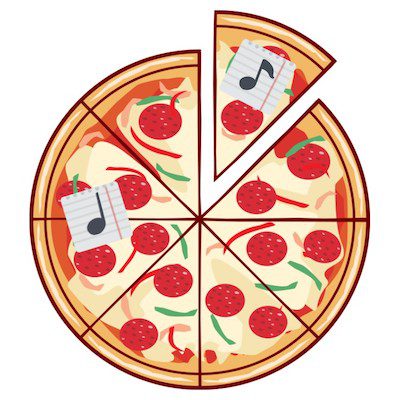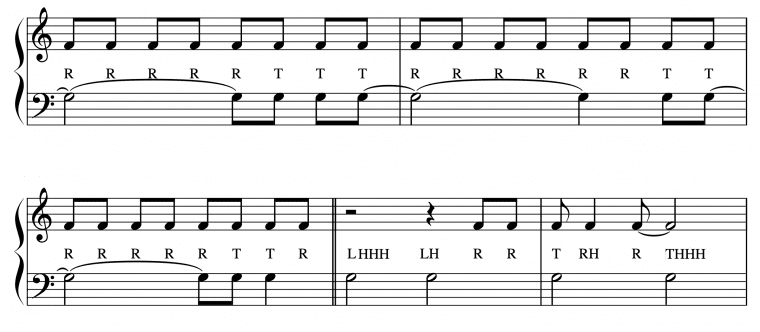Today’s post is brought to us by experienced piano teacher and blogger Andrew Bishko. Andrew is the Content and Product Manager for successful music blog Musical U. He brings with him a wealth of musical knowledge and experience.
This article is all about helping your students master rhythm. There are some fantastic ideas here and plenty of things to take away and implement in your piano studio.
Rhythm is a vital aspect of pop music. Sometimes the rhythm can be the hardest bit to learn! Students often enjoy playing the chords, but it is the rhythm of the melody that students struggle with most. Andrew’s words are here to help.
“How many counts in a half note?”
If I had a dollar for every time I asked that question there’d be a shiny new Yamaha C-5 (or two, or three) sitting in my living room. Have you noticed, as I have, that some students (did I say some?) seem particularly resistant to learning rhythm?
Long ago, I realized that reading rhythm and feeling rhythm are two separate issues. Our challenge as piano teachers is to assess which of these are holding a student back at any given time, and eventually to bridge the gap between what we feel as rhythm and what we see as dots and squiggles on the page.
When I sat down to write this guest post, I looked back over my two and a half decades of piano teaching to see what rhythm strategies I had come up with through the years. I found I could boil my rhythm teaching down to the following five opportunities to help your students master rhythm.
Pianists aren’t much for foot tapping, but have you ever watched beginner band students trying to tap their feet? As soon as the rhythm goes beyond quarter notes, they are trying to tap the rhythm of what they are playing rather than the underlying steady pulse we call “beat”.
This clued me into the fact that many music students do not have a clear concept or perception of the most fundamental rhythmic concept in Western music: the beat.
It’s not that they don’t hear the rhythm, but their perception is based on relative durations of notes rather than on measuring them against a steady pulse. This is especially true when it comes to subdivisions of the beat.
Rhythm lives in our bodies. So start with the heart: ask your student to place two fingers along the side of their throat to feel their heartbeat.

Rhythm starts with the heartbeat
This is a stronger and more easily-felt pulse point than the wrist. Ask your student to count along in twos or threes with the pulse. You can then add subdivisions, etc.
Simply clapping along with the pulse of the music works wonders. Start with singing simple songs and clapping along. Your students can also try clapping along while you play the piano.
The perception and performance of rhythmic movement bring together several different brain functions. Simple exercises coordinate different parts of the brain: simply asking your student to look right, then left while clapping a steady pulse can clear up a rhythmic sticking point in a song.
Taking it a little further, many of my younger students love to dance while I play the song they are working on. When they return to the piano their rhythm is much better.
This video demonstrates one of my favorite series of exercises, from a program called Brain Gym. They can be done quickly at the beginning or in the middle of a lesson, and break up the tension when a student is having a tough time.
For beginner students, half notes seem to be the first obstacle. The traditional method of counting beats in the measure becomes confusing since those same numbers refer to fingers. So coming up with other verbal cues that stay away from numbers can help a student to feel the rhythm.
I’ve observed that students instinctively utter some sort of syllable to help themselves feel the second beat of the half note. Often it’s a half whispered “tchoo” sound, which distinguishes it from a clearly spoken number “two” that they would use for a finger number.
Sometimes they are more imaginative—one of my students used to puff his cheeks slightly and push air through the sides of his teeth, making a sound that resembled boots walking through a mud puddle.
The word “running” for pairs of eighth notes and “walk” for quarter notes works quite well. And while we may be tempted to skip them, the lyrics to the songs in the method books can really help here. There are several Kodály-inspired rhythmic syllabaries as well.
It’s tempting to hammer away, practicing a song over and over until it’s “done”. But taking just a little break and doing something different can make a huge difference.
My students love rhythmic dictation. I don’t overdo it – it’s like a treat. I always start very simply so they experience success all along. Two measures at a time are all you need.
You might be surprised how many students are challenged by simple quarter- and half-note rhythms. And how excited they are by their “Aha!” moments.
They really have a blast if you can do it in small groups.
Does your tummy start to rumble after a long string of lessons? Invite your student to bring a round pizza to the next lesson. Have the student draw the note values – including dotted notes – on little tickets of paper.
Cut the pizza in the appropriate subdivisions and label the various slices and combinations of slices with the tickets. Playfully discuss with your student as you go (“A quarter note for me, and a dotted eighth note for you, right?”).

Teach subdivisions with pizza notes
Enjoy your delicious lesson on rhythmic subdivisions!
Metronomes—what a fantastic invention! If only they would keep a steady beat…
They always seem to speed up at the hard parts and slow down at the easy parts—at least that’s what it feels like to our students (and to me sometimes).
The main advantage of the metronome is that it takes care of the tempo aspect so the brain can focus on lining up all the note values in what I call “the grid”. But part of the issue is that the metronome demands that we see, feel, and conceive the rhythm all at the same time.
I have found it very helpful to mark up the music with “ticks”, rather than counting numbers, especially when subdividing tricky syncopations with sixteenths and eighths.

Bach Invention No. 13, m. 12, 13: Label with “Tick” marks rather than “1+2+… “
The tick marks are much easier for the eye to track. The brain is still conceiving of the grid, even when the metronome is off and the tempos are less than steady. For example, I will point at the tick marks and say “tick” along with the student, adjusting to their tempo as sections are a little more challenging. Since the brain is seeing the music in the grid, it’s much easier to adjust when the metronome is turned back on.
Popular music presents special difficulties for teaching rhythm. Just about all pop music has some sort of origin in the polyrhythmic mixture of European and African musical traditions. African music developed it’s own rhythmic concept outside of the European notation system. While the system can accurately represent these African and Pop rhythms, the resulting syncopations are not easy to read.
Since before ragtime, pianists have frequently expressed these rhythms as African drummers do, by playing two different rhythms in the different hands. Take this passage from Chopin’s Prélude in E minor:

Chopin’s Prelude in E minor, measure 18
The old adage to “always learn hands-separately” doesn’t work very well here. Here the hands are playing off of each other. I use the letters…
…for each subdivision and label the score, verbalizing with the students as they play the passage slowly:

Chopin’s Prelude in E minor, measure 18: Hands together learn “3 over 2”.
This works wonders with pop music scores too:

Hands play off each other to make rhythm: Journey’s “Don’t Stop Believin'”: end of intro, beginning of verse.
While Western music notation squares everything off in even beats, other world rhythms – especially dance-based – conceive of their music in patterns of longer and shorter pulses. Balkan and Hindu rhythms are two good examples.
This phenomenon is known as “clave” in Afro-Caribbean music. And Western pop has inherited this clave. Pop rhythms are so difficult for our students to read because this clave pattern which they feel so strongly in their bodies is obscured by the Western notation system.
Instead of labelling all the 1+ 2+ 3+ 4+’s, count pop rhythms with the pattern 123 123 12:

Pop Clave: John Legend’s “All of Me” Rhythm

Pop Clave: Accompaniment Rhythm to Adele’s Hello
Once your students have learned this “pop clave”, they will be amazed at the huge percentage of pop music from many genres is based on it. Then they will recognize Western notations version more easily.
What a wonder we have in our treasured Western music notation system – so adaptable, thorough, and flexible. Yet in order to guide our students to comprehend the challenges of today’s world of rhythm, we can step out of the traditional Western box and learn how our bodies feel and perceive rhythm.
Take advantage of these opportunities to teach (and learn) rhythm a little differently, and you will open up to your own creative teaching ideas!
What do you think about these tips? What troubles do your students have when it comes to rhythm? Could these ideas help your students master rhythm?
Leave your thoughts in the comments section below!

Danny V says:
Your strategies for teaching rhythm are, of course, common and proven methods to help the average student to perceive and become aware of pulse and its relationship to rhythm. What you overlook, or fail to mention, is that many students are victims of a learning disability we commonly refer to as “dyslexia.” We are all aware of dyslexia’s effect on a student’s reading of words and text but most of us are unaware of dyslexia’s effect on a student’s reading of music.
In music reading, dyslexia manifests itself as a difficulty to perceive pulse and its relationship to rhythm and/or to realize a distinction between pulse and rhythm. This is most often and easily observed when the student makes chronic errors in counting long notes (more than one pulse in length) and, especially, tied or dotted notes.
Roughly 20% of your students will be dyslexic to one degree or another. This commonly stated fact has been confirmed in my observations of my own students since I have become aware of this problem. Since most of my students have been older high school and college students, most of those who show signs of dyslexia (i.e.: chronic problems with rhythm reading and performance) have already been diagnosed in their younger years. So, when I ask the direct question of whether or not the student is dyslexic, most often the answer is in the affirmative. Unfortunately, they are almost always unaware of how their dyslexia affects their musical practice and performance. Also unfortunate is that their music teachers are almost always unaware of how dyslexia challenges their students. In my opinion, this is a serious weakness in our training of music teachers, considering the extent of the commonness of the condition.
If some of you reading this are surprised by my comments, I suggest you begin your own research into this condition. A simple Google search of “dyslexia and music” will yield enough results to start you down the path of learning about this condition, its effect on some of your students, and effective methods to help your dyslexic students. There is some good information out there, it is just not commonly known or taught. My own journey started by two dissertations on the subject: Raviotta, B: Developing Individual Programs for Music Students with ADHD & Dyslexia and Raviotta, S: Learning Strategies for Musicians with Dyslexia and ADHD
I would like to thank the OP for the opportunity to make these comments and I wish you all the best in your efforts to improve your own teaching with awareness of this condition.
Jacob J. says:
Rhythm is an important part of music. When teaching rhythm, teachers must make it clear what is meant by the term. Often, rhythm is taken to mean just the correct accenting of notes. However, it is more than that. Rhythm is the movement of music and should be brought out in the student’s playing by controlling the tempo, the dynamics and the volume. Teachers can benefit from the following ways to help students master rhythm and make sure they are moving musically:
rohit aggarwal says:
thanks for the information
Richmond Hill ARCT lesson says:
I like the helpful info you provide to your articles.
I will bookmark your blog and take a look at again here
regularly. I’m rather sure I will learn a lot of new stuff right here!
Best of luck for the following!
FirstLatesha says:
I see you don’t monetize your site, don’t waste your traffic, you can earn extra cash every month because you’ve got hi quality content.
If you want to know how to make extra bucks, search for:
Boorfe’s tips best adsense alternative